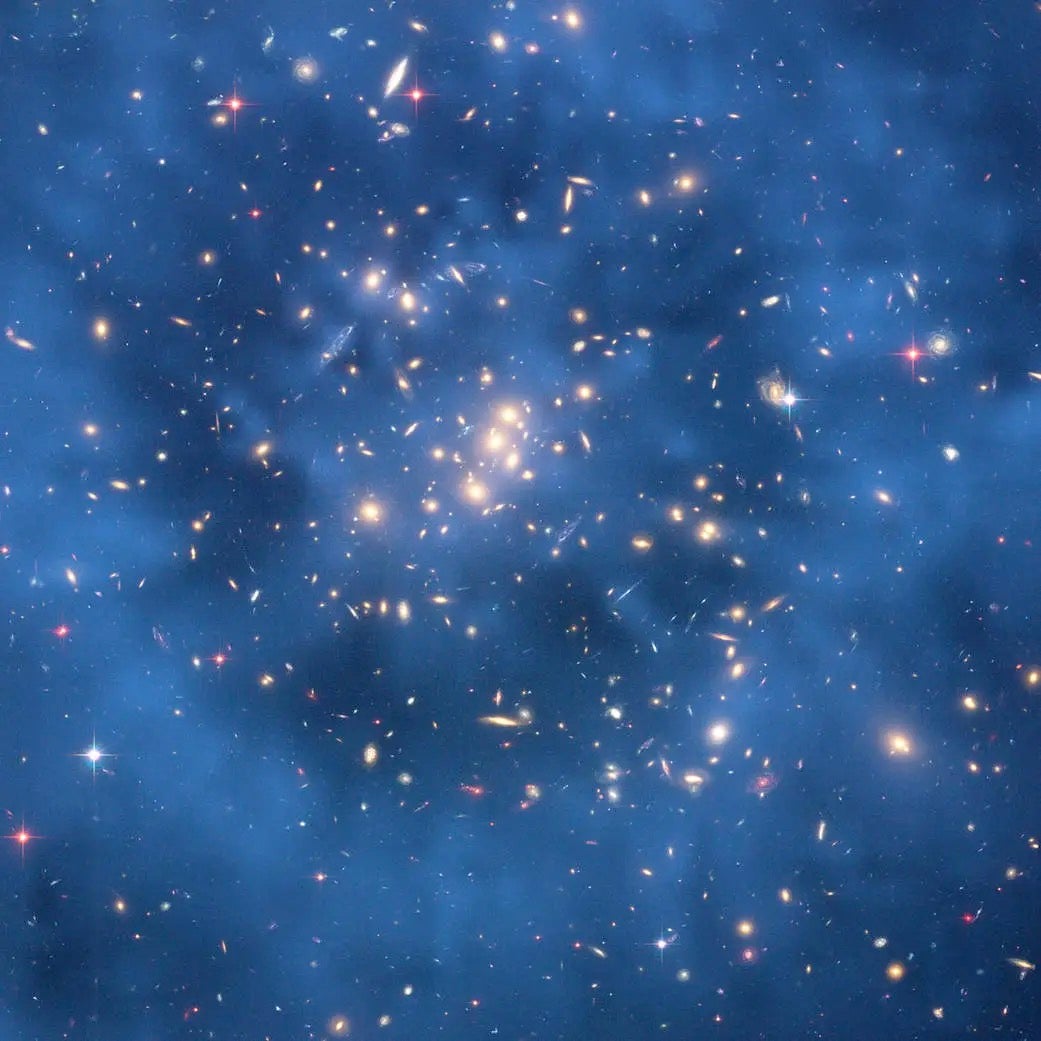
Maybe dark matter talks to itself, according to a new proposal, and that might just explain two cosmological mysteries at once.
Dark matter is the name astronomers give to the mysterious substance that makes up the bulk of all matter in the universe. Upwards of 80 percent of the mass of a galaxy exists in the form of this strange, invisible stuff. But despite our inability to directly identify it, we can see the effects it has on its environment, like providing the gravitational glue needed to keep stars in their orbits despite their incredibly rapid rotation around galactic centers.
Whatever dark matter is, in the standard cosmological picture known as CDM (for “cold dark matter”), dark matter is termed collisionless, meaning that it never interacts with itself or with normal matter. This simplistic view is able to explain a wide variety of observations at all sorts of scales, from the motions of stars within galaxies to the growth of the largest structures in the universe.
But this simplistic view isn’t perfect. Some galaxies exist that seem to defy explanation, like one designated SDSSJ–946+1006, which has such a high density that it would be difficult, if not outright impossible, for collisionless dark matter to clump together enough to build it. Another mystery is the origins of galaxies known as gas-rich ultradiffuse galaxies. These galaxies appear to have little, and maybe even no, dark matter at all — they’re just fuzzy clouds of mostly normal gas.
Precisely because astronomers don’t fully understand the nature of dark matter, they can extend models beyond the simplistic assumption that it is collisionless. Extending these models allows astronomers to potentially explain existing mysteries and also find new ways to test these ideas, if the more complex models are able to provide a way to observationally distinguish them from simple dark matter.
In a recent paper published in The Astrophysical Journal Letters, a team of astronomers used a more complex form of dark matter to explain strange galaxies that don’t fit the mold.
According to Hai-Bo Yu, a professor of physics and astronomy at the University of California, Riverside and the leader of the research team, they felt that a more complex version of dark matter could explain these two galactic extremes.
“The first is a high-density dark matter halo in a massive elliptical galaxy,” Yu says. “The halo was detected through observations of strong gravitational lensing, and its density is so high that it is extremely unlikely in the prevailing cold dark matter theory. The second is that dark matter halos of ultra-diffuse galaxies have extremely low densities and they are difficult to explain by the cold dark matter theory.”
Yu, along with Ethan Nadler and Daneng Yang, investigated a model known as self-interacting dark matter, or SIDM. In this model, it still ignores regular matter, but it’s capable of weakly interacting with itself in a galaxy’s halo, with the cloud of dark matter that surrounds and infuses every galaxy. This extra interaction allows the dark matter to exhibit more variations, because it can distribute heat and energy within the halo more efficiently.
“These self-interactions lead to heat transfer in the halo, which diversifies the halo density in the central regions of galaxies,” Nadler says. “In other words, some halos have higher central densities, and others have lower central densities, compared to their CDM counterparts, with details depending on the cosmic evolution history and environment of individual halos.”
In their work the team used high-resolution simulations of the evolution of galaxies, tracing out the behavior of self-interacting dark matter along with the evolution of the normal matter. They found that they were able to easily replicate both kinds of galaxies — ones with too much dark matter, and ones with too little.
According to the team, SIDM is able to more cleanly explain these two extremes of galaxies, opening up new avenues of research.
“CDM is challenged to explain these puzzles,” says Yang. “SIDM is arguably the compelling candidate to reconcile the two opposite extremes. No other explanations are available in the literature. Now there is an intriguing possibility that dark matter may be more complex and vibrant than we expected.”
But this research is just the beginning of exploring this intriguing hypothesis.
“We hope our work encourages more studies in this promising research area,” Yu says. “It will be a particularly timely development given the expected influx of data in the near future from astronomical observatories, including the James Webb Space Telescope and upcoming Rubin Observatory.”









